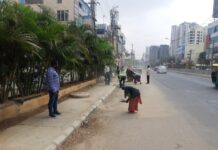New Delhi, The national capital and the areas around experienced the first smog episode of this season as the city turned into gas chamber two days before Diwali with air quality placed in “emergency” or “beyond-severe” category.
Under severe-plus or emergency category, which impacts even healthy people by letting the particle pollutant into the bloodstream, the normal dust masks fail, and even walks are advisable against. In 2016 and 2017, schools were shut down for a few days under similar conditions.
On Monday, the overnight change in weather condition, change in wind directions and impact of stubble burning in neighbouring Punjab and Haryana led to higher pollution levels.
The Air Quality Index (AQI) of Delhi was 426 at 4 p.m. The AQI, however, dropped to 435 by 7 a.m on a scale of 0 to 500.
The condition is expected to prevail till Diwali, however, it may improve if no additional emission from firecracker adds to the Delhi’s air, said the System of Air Quality and Weather Forecasting and Research (SAFAR).
Delhi may also see pollution response measure under “severe-plus” category that include parking fee hike, odd-even vehicle rationing scheme and ban on entry of trucks into Delhi. The measures are imposed by the Environment Pollution Control Authority (EPCA) if severe-plus or emergency condition prevails for 48 hours.
“Even if 50 per cent of the total load of toxic firecrackers, as compared to Diwali-2017, is added, the prevailing weather conditions will aggravate the high smoke level and make air quality to persist in severe range for at least up to November 8-9,” said SAFAR.
It added that dispersion of pollutants will not be possible, resulting in increase levels of PM2.5 and PM10 pollution, in case of firecrackers.
On Monday, the air quality of Delhi and most of the NCR fell from moderate on Sunday to severe on Monday. By 11 a.m on Monday, Delhi’s air became severe-plus, which occurs when PM2.5 or PM10, particles with diameter less than 2.5mm and 10mm, are over 300 and 500 microgrammes per cubic meters, respectively.
The safe limit, PM2.5 and PM10 has been under-60 and 100 units, as per national standards. The international standards are 25 units for PM2.5 and 50 units for PM10.
“This is the first smog episode of Delhi for this season. It is supposed to remain for a few days around Diwali. Unlike in 2017 and 2016, the EPCA has already issued directions. However, if severe-plus situation prevails, more restrictions may come in force a day after Diwali,” Shambhavi Shukla, of the Centre for Science and Environment (CSE) told IANS.
The average PM2.5 and PM10 across 35 areas of Delhi at 7 p.m were 364 and 504 units, respectively. Across NCR, the same were 358 and 494 units.
In NCR, at 4 a.m, the AQI was 435 in Ghaziabad, 425 in Greater Noida, 433 in Noida, and 421 in Faridabad, with 401 to 500 considered “severe”.
The AQI in Gurugram and Bhiwadi in Rajasthan were very-poor at 325 and 324, respectively, as the polluted air coming from north-western regions got trapped in Delhi’s high moisture air.
“Till Sunday evening, Delhi received moist easterly winds which helped in improving the air quality for the time being, but as they stopped and changed into cold north-westerly winds bringing smoke from Punjab and Haryana, the pollutants, both local and from stubble, got trapped,” Mahesh Palwat, Director of private weather forecast agency Skymet, said.









